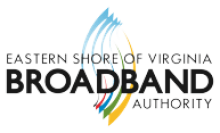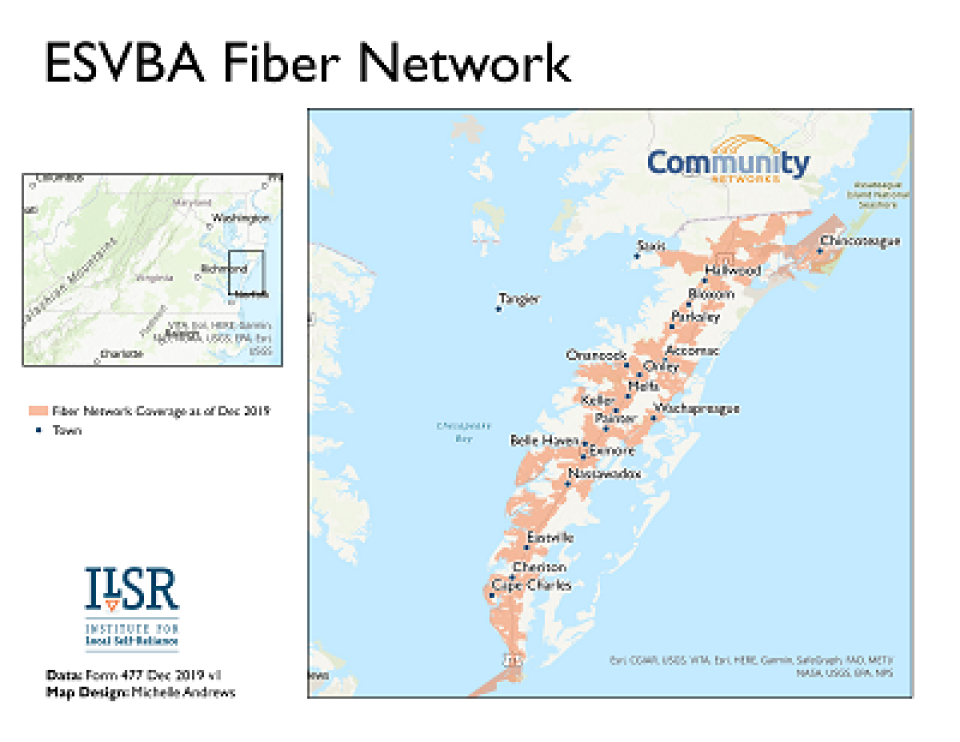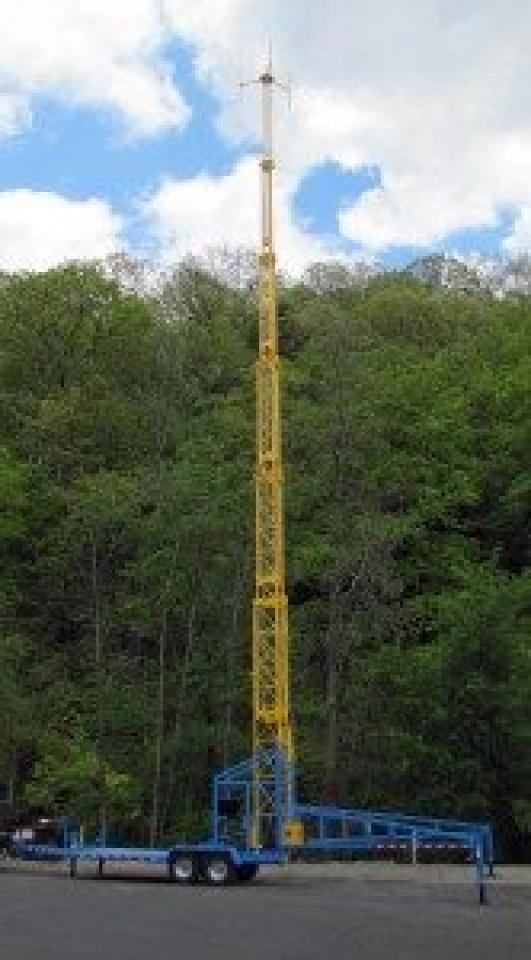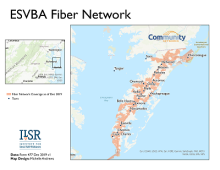
Hop in a time machine and go back to 2008. It was a banner year for NASA as the space agency celebrated its 50th birthday. Phoenix touched down on Mars, far-off planets were photographed, four space shuttles flew to the International Space Station, and the agency helped send scientific instruments to the moon aboard India’s first lunar explorer.
Meanwhile on Earth, it was the under-the-radar launch of the Eastern Shore of Virginia Broadband Authority (ESVBA) fiber network in 2008 that carried the most practical payload for the people of Accomack and Northampton counties along coastal Virginia. A popular tourist destination “for lovers,” the Eastern Shore is a 70-mile stretch of barrier islands between Chesapeake Bay and the Atlantic Ocean. And thanks in large part to funding from NASA, which operates the Wallops Flight Facility on Wallops Island, the future-proof broadband frontier had finally found its way to the region.
The two counties of Eastern Shore, Accomack and Northampton, provided an initial sum of about $270,000 to ESVBA to plan the network. It was one small step for high-speed connectivity in the Commonwealth, followed by one giant leap when ESVBA received $8 million in federal and state funds – nearly half of which came from NASA – to build the region’s open access middle mile backbone. When that part of the network was completed, the Wallops Flight Facility and its 1,100 employees were connected to it, as was the National Oceanographic and Atmospheric Administration’s Chesapeake Bay office and an array of area healthcare institutions and schools.
The Final Fiber Frontier
Funding for the last mile Fiber-to-the-Home (FTTH) expansion came from the nearly two dozen towns in the two counties. In the fall of 2016, Harborton, a small town with a little over 200 residents, was the first community to get FTTH service. And today, thanks in part to a $5 million loan secured from a private bank in 2018, and with more than 480 miles of fiber laid, ESVBA is rocketing toward total build-out (see map below, and high-resolution map at the end of this story). When the work is complete, every address in all 19 towns (pop. about 45,000) inside the two counties who want a fiber connection will have access to the network.
In February, Accomack County officials announced it would use $1.1 million in CARES Act funding to extend ESVBA’s FTTH network to 1,500 households in the communities of Big Road, Bogues Bay Drive, Creek Bluff, Dix Farm Road, Doe Crossing, Evergreen Lane, Locust Grove 2, Ox Hearth-Bethel Church, Hillsborough, and Metompkin View.
Evolving Against the Odds
Offering an array of services – including residential and a variety of services for businesses and potential ISP partners – the evolution of ESVBA is a rare success story in a state starving for broadband.
Even in the midst of a pandemic which clearly exposed the necessity for universal access to broadband, Virginia is one of the 19 states in America with big telco-friendly laws that make it difficult for municipalities to build their own networks, prompting community broadband advocates in Virginia to note that while the state motto may proclaim Old Dominion as a state for lovers, “Virginia is currently not for lovers of public broadband.”

“While the Code of Virginia does not outright ban localities from creating public entities that provide retail Internet service to residents and businesses in Virginia, the existing restrictions (one of which arbitrarily prohibits municipal networks from charging less than incumbent competitors for any equivalent service) make it basically impossible for municipal providers to be competitive or even get off the ground. One path is for localities to form a ‘wireless service authority’, which allows localities to form a paragovernmental entity that can offer Internet and telephone service. Several cities and counties have done this to great success,” as the grassroots group ArlFiber noted, holding up the ESVBA and the Roanoke Valley Broadband Authority as examples.
While residential customers are not offered gig speed connections, ESVBA does offer four tiers of residential service, three of which surpass the FCC’s minimum speed for broadband, 25/3 Megabits per second (Mbps). ESVBA’s highest residential speed is a 100/50 Mbps connection for $176 a month with a one-year contract ($150 a month with a two-year contract). The network also offers 50/25 Mbps, 25/12 Mbps, and 10/5 Mbps service.
Typically, municipal FTTH service providers offer subscribers up to a Gigabit per second symmetrical connections with the lowest speeds in the 100 Mbps range, with prices between $50 and $100 per month. It’s not clear to us why ESVBA speed and price offerings are out of those ranges. Multiple calls and emails to ESVBA managers to get better insight on the pricing and speed packages being offered on the Eastern Shore were not answered.
Hope on the Horizon
Hope for the expansion of municipal broadband in Virginia may be on the horizon. In January of 2021, Gov. Ralph Northam announced $29.6 million in grants awarded through the Virginia Telecommunication Initiative (VATI), the bulk of which will flow in two directions. The first is to the Northern Neck Planning District Commission and All Points Broadband to build a “gigabit-capable” network in the northern part of the state. The second is to the Cumberland Plateau Planning District Commission and Point Broadband to lay 1,300 miles of fiber in the western part of the state.

If “the Mother of States” eases restrictions on municipal networks and ramps up broadband infrastructure investment, communities across the Commonwealth will be more resilient in the face of crises. When the COVID pandemic hit, school officials scrambled to ensure students without access to broadband had at least some connectivity. ESVBA answered the call at the outset of the quarantine protocols, making 13 free Wi-Fi hotspot locations immediately available for public access.
“Our mission has always been to provide as much broadband access as possible across our region,” ESVBA’s Executive Director Robert Bridgham said when the hotspot availability was announced. “Until every home and business has affordable high-speed access, we will continue to look for ways to increase equity as much and as fast as possible.”
ILSR GIS and Data Visualization Researcher Michelle Andrews created the fiber map for this story
Header image from flickr user Roiz Roiz via Creative Commons CCY by 2.0









